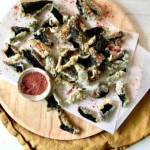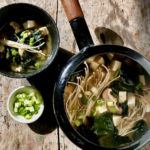Note that if you purchase something via one of our links, including Amazon, we may earn a small commission.
In recent decades, the demand for edible seaweed has risen sharply as a result of both of its culinary and nutritional value. According to the USDA, seaweed production has grown from eighteen tons in 2017 to about 440 tons in 2021. The cold and clean waters of the Gulf of Maine are an ideal place to cultivate various types of seaweed. Because seaweeds are typically harvested in the winter, they can be grown in the off-season, when lobstering and recreational fishing have slowed down. Winter seaweed farms have helped create a means for diversification among seafood producers, creating a new, sustainably sourced cottage industry for Maine.
As a cookbook author and recipe developer living in Maine, I love to incorporate seaweed into my recipes, since it allows me to take advantage of the fresh and world class seaweed available in Maine. The seaweed and kelp varieties featured in the four recipes that follow are farmed off the Gulf of Maine, but can be purchased online nationwide in packaged and dried form.
Here are the products I used:
- Vitamin. Sea. Smoked Whole Leaf Dulse (Applewood Smoked Wild Atlantic Seaweed) 1.5 ounces (42 g)
- Maine Coast Sea Vegetables, Kelp, Dried Wild Atlantic Kombu, 2 ounces (56 g)
- Ocean’s Balance, Dried Organic Sea Lettuce Flakes 1.5 ounce package (42 g)
- Maine Coast Sea Vegetables, Organic Alaria Whole Leaf 2 ounce Bag (Alaria esculenta) — “Wild Atlantic Wakame” — Wild-Harvested Sea Vegetable

RECIPE: Carrot and Sea Lettuce Salad in a Ginger Sesame Dressing
- Yield: Serves 4
Description
This vibrant, crunchy salad makes a wonderful starter or side and a welcome addition to a potluck picnic or office lunch. It holds up well out of the fridge if needed, remaining fresh and crispy. Sea Lettuce is a flavorful, briny, ocean-flavored seaweed that is high in calcium, iron, and magnesium. It is harvested off the northern coast of Maine.
Ingredients
- 1 cup (about 1/2 ounce) Sea Lettuce flakes
- 4 tablespoons extra virgin olive oil, divided
- 4 cups grated carrots (from 1 pound carrots)
- 1 cup frozen, thawed shelled edamame beans
- 6 tablespoons unseasoned rice vinegar
- 1/4 cup low sodium soy sauce
- 3 tablespoons mirin
- 2 tablespoons sugar
- 1 tablespoon freshly grated ginger
- 1 tablespoon toasted sesame oil
- 2 cups thinly sliced seedless or English cucumber (from 1 whole cucumber)
- 2 tablespoons toasted sesame seeds
Instructions
- Place the sea lettuce in a medium bowl and cover with 1 cup cold water. Let sit at room temperature until reconstituted, about 5 minutes. Drain the sea lettuce well using a fine-mesh strainer, and transfer to a large bowl. Set aside.
- In a medium skillet, heat 1 tablespoon olive oil over medium heat. Add the carrots and edamame and cook, stirring occasionally until the carrots are crisp-tender, about 4 minutes. Transfer the carrots and edamame to the bowl with the sea lettuce and let cool slightly, about 5 minutes.
- Meanwhile, in a small bowl, whisk together the vinegar, soy sauce, mirin, sugar, ginger, sesame oil, and the remaining 3 tablespoons olive oil.
- Pour the dressing over the salad, top with the cucumber and sesame seeds, then toss well to combine. Let sit out until the salad reaches room temperature, then serve or refrigerate until ready to serve. The salad can be eaten right away, or stored refrigerated in an airtight container for up to 3 days.

RECIPE: Seasoned Crispy Rice and Nori Chips
- Yield: Serves 2 to 4 1x
Description
This recipe uses nori (also sometimes called laver), a type of red algae. The algae grows and is farmed in the waters off of Japan, Korea, and China and can also be found and harvested in the North Atlantic Ocean. At least five different varieties of native nori grow along the coast of Maine. To make sheets of nori, the leaves are dried and then pressed into paper-thin squares. Nori is most often used in making sushi, but it can be used in other applications such as this recipe. It is naturally lightly salty, nutty, and umami flavored, and it is highly nutritious, containing iron, B vitamins, iodine, zinc, magnesium, and manganese. These chips — inspired by Korean-style seaweed chips, but with a few western elements like olive oil, smoky paprika and powdered garlic — make a flavorful and crispy starter or snack.
Ingredients
- 8 sheets (approximately 8-inch by 8-inch squares) of Nori seaweed
- 8 rounds (approximately 8 1/2 inches in diameter) of rice paper spring roll wrappers
- 2 teaspoons smoked paprika
- 1 teaspoon onion powder
- 1/2 teaspoon garlic powder
- 1/2 teaspoon fine sea salt
- 1 cup extra virgin olive oil
Instructions
- Have ready a large high-sided plate or pie dish filled with 1 cup hot water. Have ready 2 large cooling racks and a standard-sized baking sheet lined with paper-towels.
- Soak a piece of the rice paper in the water just until it starts to soften, about 20 seconds, and quickly place it over a sheet of seaweed, pressing down and pushing out any air bubbles until it smoothly adheres. Transfer to the cooling rack. Repeat this process with the remaining rice paper and seaweed sheets, folding in the corners of the seaweed to fit the rounds.
- Let the seaweed-rice sheets dry on the cooling racks until they are less sticky but not completely firm, about 1 to 2 hours.
- Meanwhile, in a small bowl, stir together the paprika, onion powder, garlic powder, and salt, and set aside.
- Once the seaweed is ready, use kitchen shears to cut the sheets into approximately 2-inch squares.
- Heat the olive oil in a medium saucepan over medium heat until the oil reaches 360℉.
- Fry a batch of the squares until they are crisp, about 10 to 20 seconds, then transfer them to the prepared baking sheet and immediately sprinkle the spice mixture over the top. Repeat with the remaining seaweed squares and spice mixture. If the oil starts to smoke or get too hot, reduce heat to low. Serve immediately.

RECIPE: Miso Soup with Wakame Seaweed, Tofu, and Mushrooms
- Yield: Serves 4
Description
This hearty, mushroom-flavored miso soup is comfort in a bowl. I like to bring it to anyone who needs a pick-me-up. Living in Maine, I love to incorporate seaweed into my recipes. This one uses two kinds of sea vegetables: kombu and wakame. Kombu, a type of kelp that generally comes in the form of large, thick, dried leaves, is high in B vitamins and calcium, and contains a natural flavor enhancer, glutamic acid, which makes it ideal for flavoring broths like this one. The second type of seaweed used here is alaria, also known as wakame, which usually comes dehydrated and is a great source of iron, calcium, fiber, potassium, and vitamins A and B6. Once reconstituted, it will give your dishes a beautiful green color and a delightfully chewy texture.
Ingredients
For the broth:
- 1/2 ounce dried kombu seaweed pieces
- 1/2 ounce (about 1/2 cup) katsuobushi (dried bonito flakes)
For the soup:
- 1 ounce (about 1 cup) dried sliced shiitake mushrooms
- 1/2 ounce (about 1/2 cup) dried alaria (wakame) seaweed, cut into 1-inch pieces
- 1/4 cup low-sodium soy sauce
- 1/4 cup mirin
- 1/4 cup sweet white miso paste
- 4 ounces enoki mushrooms, ends trimmed
- 1/2 pound firm tofu, drained well and cut into 1/2-inch cubes
- 1/2 cup thinly sliced scallions
Instructions
- Combine the kombu and 4 cups water in a small saucepan. Bring just to a simmer over medium heat, about 6 minutes. Turn off the heat. Add the bonito, cover, and steep to let the flavors develop about 12 minutes.
- Meanwhile, in a medium saucepan, combine the shiitake mushrooms, wakame, soy sauce, mirin, and 2 cups water, and bring just to a simmer over medium heat, about 6 minutes. Reduce heat to medium-low and continue to simmer until the shiitakes are reconstituted and tender, about 4 more minutes. Turn off the heat.
- Pour the kombu mixture through a fine-mesh strainer over the mushrooms in the saucepan. Discard the strained kombu and bonito.
- With heat off, stir the miso paste into the soup until smooth, then gently stir in the enoki mushrooms, tofu, and scallions. Bring the soup back up to a simmer over medium heat and continue to simmer until the mushrooms and tofu are warmed through, about 4 minutes. Serve immediately or within a few days.

RECIPE: SDALT Sandwiches with Smoked Dulse
- Yield: Serves 2
Description
Dulse, a seaweed with a briny and clean flavor, is rich in iodine, potassium, irons, and vitamins B6 and B12, and thrives along the rocky outcroppings of the Maine coast. In this recipe, I use pre-smoked, dried dulce to mimic the taste and texture of the bacon found in a traditional BLT sandwich, resulting in a healthier, vegetarian-friendly alternative. I’ve added to the mix creamy avocado and a slightly sweet and tangy tomato and mayo spread that complements the dulse’s smokiness.
Ingredients
- 1/4 cup vegan or regular mayonnaise
- 1 tablespoon tomato paste
- 1/2 teaspoon garlic powder
- 4 slices sourdough bread, toasted
- 1/2 of 1 small head bibb lettuce, ends trimmed and leaves separated
- 1 large, ripe tomato, sliced
- 1 ripe avocado, halved, pitted, peeled, and sliced
- Sea salt and freshly ground black pepper
- 2 tablespoons extra virgin olive oil
- 1/2 ounce (about 1 1/2 cups) smoked whole leaf Dulse seaweed
Instructions
- Line up the slices of toast on a large cutting board.
- In a small bowl, combine the mayonnaise, tomato paste, and garlic, and stir until combined, then spread the mayonnaise mixture onto one side of each slice of bread.
- Top two of the slices with equal amounts lettuce, tomato, and avocado.
- Heat the olive oil in a medium, heavy-bottomed skillet over medium heat. Add the dulce to the skillet, using tongs to toss a few times until the dulse is crisp, about 2 minutes. Immediately place the dulse on top of the sliced avocado.
Top each sandwich with one of the two remaining slices of bread, and serve immediately.


